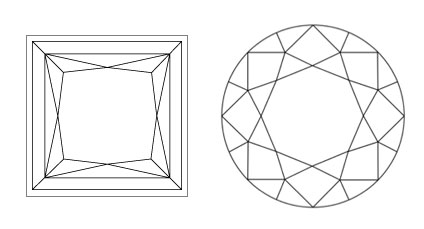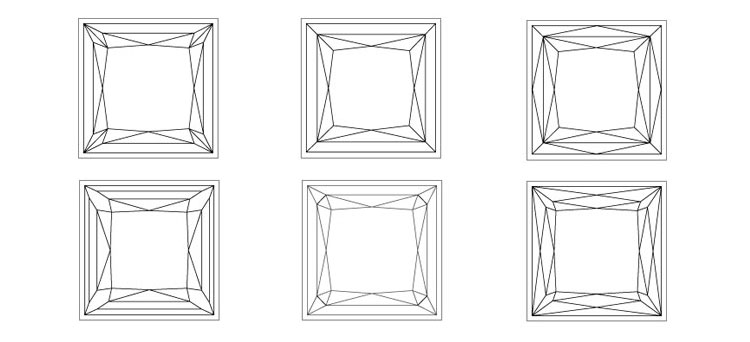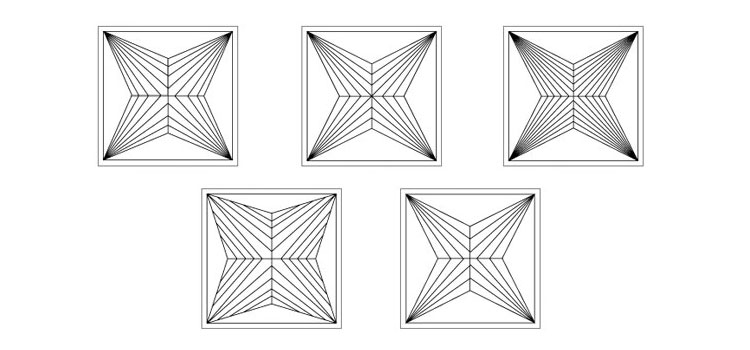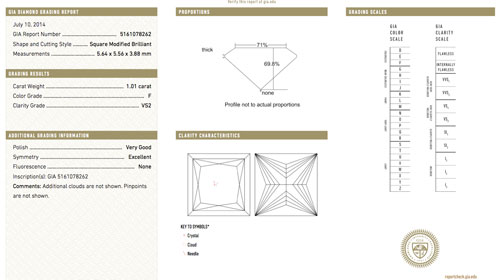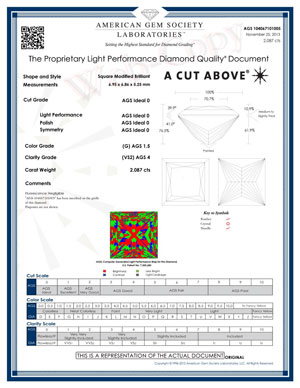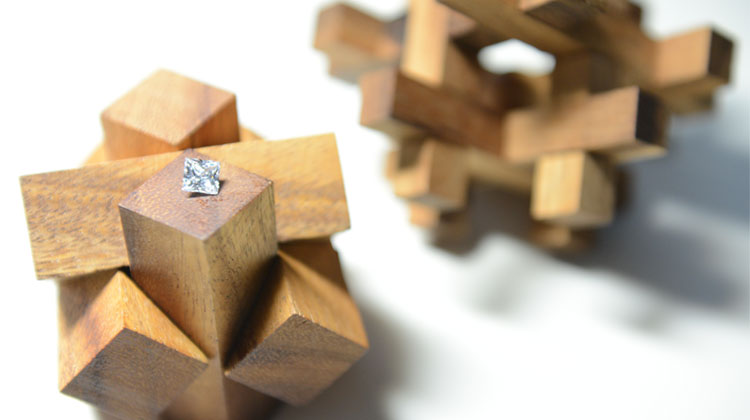
A princess cut diamond is traditionally square in shape and you will find that it is referred to as a “square modified brilliant” in lab reports. The term modified refers to the cut being non-standard and most brilliant-cut fancy shapes will be referred to as modified.
For a princess cut to take on a square shape, the length-to-width ratio should be between 0.95 – 1.05. This is the standard set by the AGS to still be within the AGS0 in cut grade for a princess cut. A perfect princess cut should have a 1.00 length-to-width ratio and this is the only way to maintain perfect symmetry in a princess cut.
There are also princess cut diamonds that are rectangular. These are usually cut for weight retention so are less expensive, but will have more unpredictable light performance. The difference in price between a square and rectangular princess cut can be significant and depending on the overall weight retention can be up to 10%.
Princess Cut vs Modern Round Brilliant Cut
I’m building up from some of the basics that I’ve covered in other tutorials so if you’re new to diamonds, you may find it helpful to revisit some of the basics of round diamonds if you’re finding this difficult to follow.
Round diamonds have fewer facets and have circular symmetry. This makes round brilliants easier to design, cut and buy. Because of this, it has been possible to identify a range of angles for all the facets that optimise the light performance in a round.
Princess cuts have more facets, complicated angles, and less symmetry so what you’ll find is that even in the best princess cut, the light return at its edges and corners will be from the periphery and indicated as green on an ASET image.
What this means is that those areas will not be as bright as in a round where we have come to expect excellent edge-to-edge light performance. To compare a round to a princess is therefore comparing apples to oranges. Most official cut grading systems recognise this so princess cut diamonds are not graded on the same light performance scale as round diamonds.
For the same carat weight, will a princess cut be larger than a round?
The surface area of a round = π x r2
The surface area of a princess cut = 4 x r2
Since π ≈ 3.14, we can see that for the same diameter, the surface area of a princess cut diamond is roughly 25% larger than for a round diamond. However, that princess cut will be 25% larger in carat weight. This means that for the same carat weight, the surface area of both round and princess cut diamonds are similar.
You can estimate the carat weight of a princess cut diamond without a girdle using the following formula:
Length(mm) x Width(mm) x Depth(mm) x 82/10000
So which looks bigger? It all boils down to perception.
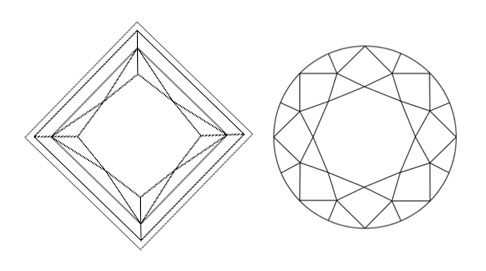
Princess cuts do have one advantage over round diamonds, and that is they usually have a higher rough yield. This means that a cutter can extract a larger diamond out of the rough diamond when producing a princess cut than they can for a round and is why princess cuts have traditionally been significantly less expensive than rounds on a price per carat basis.
However, as you will see later in this tutorial, super-ideal princess cuts have a much lower rough yield than typical princess cuts. This means that if you’re in the market for the best-cut princess cut diamond, be prepared to pay much more than the average princess cut with the otherwise same specs.
Types of Princess Cuts
So you’ve decided that you want to buy a princess cut diamond. But there’s still the matter of what kind of princess cut. What you need to know is that there are quite a number of different types of princess cuts, all with a slightly different look. This is because there can be many configurations of crown side and pavilion side facets that when combined produce many different flavours of princess cuts.
Crown Side
The second diamond on the top row is the original princess cut diamond known as a “French Cut”. The first diamond on the bottom row is the “Bezel Cut”. The bezels are added to protect the fragile corners in the French Cut. As you can see, there are different variations of both French and Bezel cut crowns.
Pavilion Side
Each type of pavilion differs in the number of chevron facets. The chevrons are the V-shaped facets and you will typically find 2, 3, or 4 sets of chevrons in most princess cut diamonds. The chevrons have a huge impact on the princess cut and I will be discussing them in more detail later in this tutorial.
GIA Cut Grading System
In all diamonds, it is the pavilion facets that are the main drivers of light performance. Hence, GIA’s reporting method, which provides only the table % and the depth % is not even close to being sufficient for evaluating light performance. The problem is that GIA doesn’t issue an overall cut grade for princess cuts, and instead only provides grades for polish and symmetry.
A GIA report basically only gives you the table and depth percentages so you cannot draw any valid conclusions on light performance. Here is an example of what the GIA lab report for a princess cut diamond looks like.
I can only speculate about the reasons why GIA hasn’t introduced a cut grade for princess cuts.
Prior to 2005, before AGS published their diamond cut grading system based on light performance, the only princess cut standard available was the GIA Ex/Ex in polish/symmetry. But because the primary objective of a diamond cutter is to maximise the selling price of a diamond, there is great pressure on cutters to maximise the carat weight of any given diamond.
Many princess cuts were therefore cut with very large tables and shallow crowns and focus was given to achieving GIA excellent polish and symmetry rather than on maximising light performance. There are still such a large number of poorly cut princess cut diamonds on the market that if GIA introduced a cut-grade for princess cuts, it could severely affect the marketability of these existing stones.
AGS Cut Grading System
For princess cuts, having AGS certification is superior to GIA certification. On top of having more information, the AGS Platinum Light Reports have a computer-simulated ASET available to verify light performance in the same way as rounds.
Even today, there are not many cutters cutting to the AGS0 standard for princess cuts. One reason is that cutting an AGS0 princess cut requires more skill and time for the cutter. More importantly, it’s again a matter of economics so let me try to explain how a cutter sees the situation.
A piece of rough can be cut to produce two equally large princess cut diamonds with poor light performance. The same piece of rough would only produce a single slightly larger AGS0 princess cut diamond and another much smaller diamond of lower value. The cutter therefore has to sell that AGS0 for a much higher price than the two slightly smaller princess cuts with poor light performance.
Hence, even though the AGS0 princess cut diamond is much superior to its traditional counterpart, consumer demand has been relatively low because an AGS0 princess cut is so much more expensive.
Proportions
Let me explain a bit more about princess cut proportions you should be aware of.
- Table – Represented by the “Table Percentage” and measured as a % of the width.The table facet of a princess cut can vary from 55% to over 80%. A smaller table leads to a higher crown.
- Crown – Represented by the “Crown Height” measured as a % of the width and the “Crown Angle”.There are two main crown facets in a princess cut, C1 and C2. The crown angle is the angle C1 makes with the girdle. The angle of C2 is not represented on the lab report.
- Pavilion – Represented by the “Pavilion Depth” measured as a % of the width and the “Pavilion Angle” measured as the angle the pavilion makes with the girdle.There are also two main pavilion facets in a princess cut, P1 and P2. P2 sets the depth of the pavilion and therefore the pavilion angle is the angle P2 makes with the girdle. The radial position of P2 is defined by the “Lower Pavilion Ratio” and is expressed as a % of the width.The angle of P1 is not represented on the lab report and it is here that cutters can hide a lot of weight in a princess cut. The radial position of P1 is defined by the “Upper Pavilion Ratio’.
- Star Facet – Not represented on the lab report, it is defined by the star facet’s azimuth angle. For more information about the azimuth, please refer to my tutorial on facet yaw.
- Girdle – Represented by the “Girdle Thickness”, which is a description of its thickness and a measurement as a % of the width.
- Culet – Represented as a description of its size.
- Chevrons – Not represented on the lab report, they are defined by their radial position from the culet expressed as a % of the width and the chevron’s azimuth angle.
Chevrons
A princess cut diamond with 4 chevrons is more difficult to cut to a high degree of symmetry than one with 3 chevrons so what you’ll find is that there are more 2 and 3-chevron princess cut diamonds available. Also with more chevrons, P1 becomes steeper and that means more weight is retained, which negatively affects the spread of the diamond.
A princess cut that has four chevrons is better optimised for pin-fire flash. Similarly, it can be said that a princess cut with two chevrons is optimised for bolder flashes of fire. Based on this logic, the 3-chevron configuration would seem to provide the most balanced look to the princess cut.
Rejection and Prediction Tools
Before the existence of the AGS Cut Grading System, the best, or rather more like the only princess cut rejection tool available for consumers were the AGA cut charts created by David S. Atlas during the late 80s and early 90s.
The AGA cut charts provided eight classifications ranging from Class 1A to Class 4B. Class 1A was considered ideal-cut and had the following proportions:
Table Percentage: 62 – 68%
Crown Height: 10 – 15%
Girdle Thickness: Very Thin (0.4%) to Slightly Thick (4.5%); or Thin (1%) to Thick (5.5%)
Total Depth: 64% – 75%
L/W Ratio: 0.95 – 1.05
On top of this, it was provided as a sound piece of advice that in general, the table percentage should never be larger than the depth percentage. Now the recommended depth percentages may seem very deep if you’re more familiar with round diamonds. The thing to remember is that for round diamonds, the depth is measured as a % of the diameter, which is the same as it’s diagonal.
In a princess cut, the depth is measured as a % of the width, which is much smaller than it’s diagonal, and this makes the depth percentage in a princess cut seem deeper than what we’re used to seeing in a round.
With the advent of the AGS Cut Grading System, the “Square Princess Guidelines to the Trade” cutting guidelines were released by AGS to support the diamond industry. Although the AGS cut charts are not meant for grading, they are still better than the previous AGA cut charts for predictive purposes.
It’s important to remember that the AGA cut charts were never meant for selection purposes and some people still view the now outdated AGA cut charts as a useful rejection tool. The AGS and AGA cut charts are not always in agreement and there are combinations of proportions that the AGS cut charts show as AGS0 that the AGA cut charts reject. Similarly, there are combinations of proportions that are outside the ideal-cut range of the AGA cut charts that AGS predicts as AGS0.
The AGS cut charts confirmed that princess cuts with a high crown generally have better light performance and this confirmed what David Atlas has been saying for so many years that princess cuts with smaller tables and high crowns produce the best princess cuts. It is interesting that despite the AGS0 princess cut having a higher crown than traditional princess cuts; the AGS0 still has very good spread because the pavilion is not cut as deep.
The only way a princess cut diamond can be properly called an AGS Ideal-cut is if it was sent to AGS and graded that way. However, there is a predictive tool called the AGS Performance Grading Software (PGS) that can determine, using ray-tracing software and a computer scan of the diamond, whether a diamond has AGS ideal light performance.
You may be wondering whether you need to ask for an idealscope or ASET when choosing a princess cut. The answer depends on what you’re looking for. If you’re looking at a GIA EX/EX and the vendor hasn’t give you any other information, perhaps the best bet is to ask for an idealscope and ASET. At the very least you can get a better idea about the face-up light performance and contrast pattern.
If you’re looking at a diamond that has AGS0 in light performance, then getting an idealscope or ASET is a bonus. You should be aware that although the AGS lab report only shows one face-up view of the ASET, the AGS Cut Grading System actually evaluates the ASET at many different tilt angles.
Sometimes, I’m asked why the computer-simulated image on the lab report doesn’t match an actual ASET photograph provided by a vendor. The reason is because the AGS computer-simulation is based on a few important assumptions. First, the azimuth of the star facet is assumed to be six degrees. Second, it is assumed that the width at mid-point of the crown facets are equal. Finally, there are assumptions made about the chevrons.
If a cutter doesn’t follow these assumptions when cutting the diamond, then there will be a visual difference between the AGS computer model and the real diamond. On top of this, a computer simulation also makes assumptions about lighting and the observer so different lighting conditions and camera setups can produce varied results.
How to Pick a Princess Cut Diamond
In some ways picking a princess cut diamond is easier than a round diamond. The simplest way is to buy an AGS ideal-cut princess cut. This way, you’re not only guaranteed to have a diamond that receives an AGS0 in light performance, but also AGS0 in polish and symmetry as well.
There are valid reasons why you may want to buy a GIA certified diamond so if you’re considering a GIA EX/EX, you should only be looking at diamonds from a vendor equipped with a Sarin/OGI/Helium scanner who can provide you with the information from a full scan of the diamond, not just the summary info. The vendor should also be able to run an AGS PGS report indicating that the princess cut is predicted to receive AGS ideal light performance.
Picking a princess cut that meets both the criteria for AGS0 in light performance and the criteria for GIA EX/EX may seem like getting the best of both worlds, but it still doesn’t necessarily mean that a diamond in this range is the right diamond for you. There will be diamonds in this range that appeal less to you than diamonds outside of this range.
Light performance is not the only thing that determines the beauty of a diamond. You are far better off getting an AGS1 with a contrast pattern that you prefer over an AGS0 with a contrast pattern that you dislike. This is why it’s not actually that important anymore for us to specifically look for a really narrow range of proportions like in a round.
Although there are many combinations of proportions that can produce an AGS0, once you settle on certain parameters, the range of the other proportions that work best become very narrow. The combinations that work are also more complicated than in a round, which makes the princess cut a more difficult shape to cut to AGS0 standards.
However, even among AGS0 princess cuts, you can still choose the best of the best. Let’s say you have two AGS0 princess cut diamonds and you love the contrast pattern of both diamonds. How should you choose between these?
Well, I’m sure this is an academic point, because in reality chances are there are other differences in characteristics that are more important than this distinction. But if I had to choose, I would pick the AGS0 with a smaller table and higher crown because these generally produce a diamond with more fire. I would also choose a diamond with a low upper pavilion ratio of 50%.
After playing around on Diamcalc, I think I’ve found my favourite set of princess cut specs:
Number of Chevrons: 2
Table Percentage: 55%
Crown 1 Angle: 40 degrees
Crown 2 Angle: 34 degrees
Pavilion 1 Angle: 58 degrees
Pavilion 2 Angle: 39 degrees
Upper Pavilion Ratio: 50% – 55%
Lower Pavilion Ratio: 10%
Girdle Thickness: Thin to Medium (2 – 3%)
Total Depth: 75%
L/W Ratio: 1.00
Conclusion
To end this article, I just want to mention that it is important for princess cut diamonds to be set in a 4-prong setting that covers all four corners of the diamond. If you’re concerned about the fragile corners, you can choose a Bevel Cut princess in order to protect the diamond against chipping during the intense pressure that is applied during the setting of the diamond.
Another thing that you should bear in mind is that princess cut diamonds tend to retain more color in the stone than round diamonds. This means that you should go up one color grade than a round diamond of the same carat weight to be safe.
I hope that after reading this tutorial that you don’t stress too much about exact proportions. It’s far more effective to start with the AGS0, then look at the ASET to see if you like the contrast pattern. The general rules of interpreting an ASET apply to princess cuts as they do for rounds. If you need help picking a princess cut diamond or evaluating it’s light performance, please don’t hesitate to contact me.
